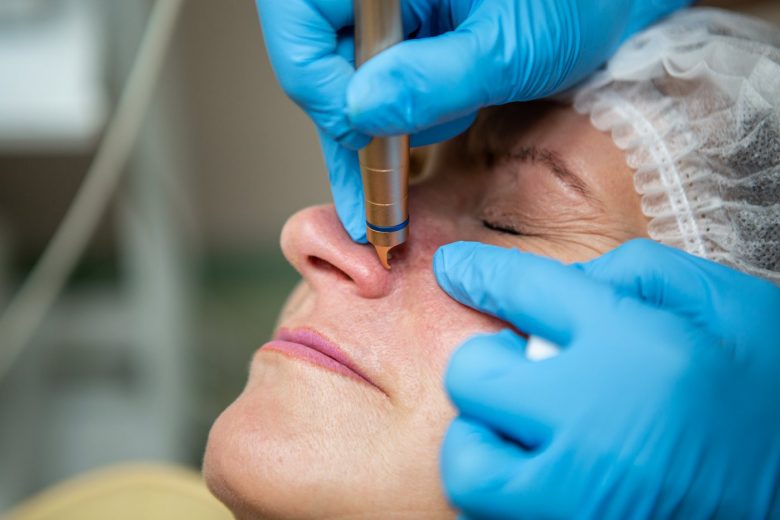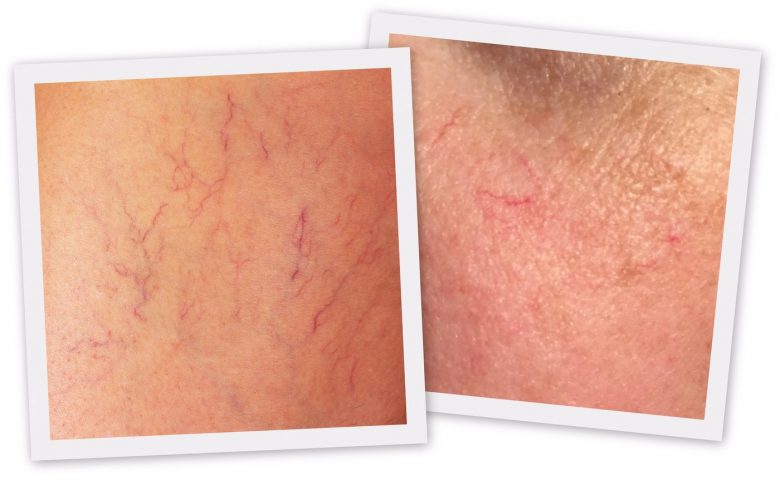Wondering why your face is peppered with tiny pink or red lines?
These broken blood vessels affect millions of people — especially as age creeps up — and don’t typically disappear on their own.
Tiny little lines
Known as telangiectasias, the tiny spider or thread-like open (dilated) blood vessels can develop anywhere on the body, but are especially common on the face. The vessels involved can be veins or capillaries, and tend to cluster around the nose, cheeks and chin.
Perhaps most commonly, these spider veins are found in areas of chronic sun damage in fair-skinned people, says Horatio Wildman, MD, an Associate Professor of Clinical Dermatology at Weill Cornell Medical College.
“Spider veins on the face don’t hurt, and they aren’t dangerous or life-threatening, but they certainly affect appearance and self-esteem,” explains Dr Meryl Becker Joerg, MD of Advanced Dermatology PC. “They can make the face appear slightly bruised and… these broken blood vessels are likely to get worse over time if left untreated.”
What causes broken blood vessels?
Some telangiectasias are prompted by uncontrollable factors, while some show up because of a variety of everyday things in our lives. For example, some of the causes of broken facial blood vessels include:
- Aging
- Prolonged sun exposure
- Pregnancy and childbirth
- Chronic systemic or topical corticosteroid use
- Oral contraceptive use (birth control pills)
- Estrogen replacement therapy
- Excessive alcohol use
- Genetics (heredity)
- Rosacea, a common skin condition triggering facial redness from a combination of bumpy skin, pimples and broken capillaries
According to researchers at Boston University School of Medicine (BUSM), telangiectasias are also common to a number of disorders, including acne, birthmarks (port-wine stains), and with several types of inherited disorders (including ataxia-telangiectasia, hereditary hemorrhagic telangiectasia and xeroderma pigmentosum).
Information from Dr Wildman notes that some autoimmune and connective tissue diseases associated with telangiectasias include scleroderma, dermatomyositis and Systemic Lupus Erythematosus (lupus).
Gentle skincare and sun protection
Wildman says that activities that trigger blushing or facial redness can worsen telangiectasias — including UV radiation, strong wind, hot drinks, and spicy food.
It may not be possible to completely avoid broken facial blood vessels, but Joshua Fox, MD, also of Advanced Dermatology, says that there are several ways to minimize your risk, such as gently washing your face with warm — not hot — water, since hot water forces capillaries to expand.
Also, use mild cleansers on your face (and other areas of delicate skin), make sure to protect your skin from the sun with sunscreen and other barrier methods (such as hats and clothing), and minimize your skin’s exposure to temperature extremes.
“Everyone who comes to us with broken blood vessels on their face seems to have acquired them in a different way,” Fox says.
Makeup options
Makeup or self-tanning lotion can be used to try to conceal or camouflage broken blood vessels, but don’t actually remove the problem blood vessels.
Skin-toned cover-up can hide mild telangiectasias, Wildman says, and suggests that for more prominent telangiectasias and facial redness, a slightly green-tinted foundation or moisturizer can help to neutralize the color.

Modern treatment options
Broken blood vessels in your face can, however, be treated quickly and effectively by a dermatologist, says Fox.
One treatment option for broken blood vessels is laser light treatment, which uses gentle light pulses to heat the affected blood vessels, causing them to collapse and leaving the surrounding skin undamaged. Afterward, the tissue from destroyed blood vessels simply dissolves, restoring the skin’s natural appearance.
While some laser light treatment patients describe the laser sensation as similar to that of a snapping rubber band, topical anesthesia or ice can be applied before treatment to maximize comfort.
Larger veins may require multiple laser treatments spaced weeks apart, while small vessels can usually be taken care of with a single, 10- to 15-minute treatment. Bruising, crusting or redness of the skin may occur in some cases, but typically clears within a few days.
For optimal results, Fox recommends laser or intense light treatment, and that patients use sunscreen on the treated area to ward away unnecessary redness or discoloration. (Daily sunscreen use on the face is a good idea regardless, he adds.)









